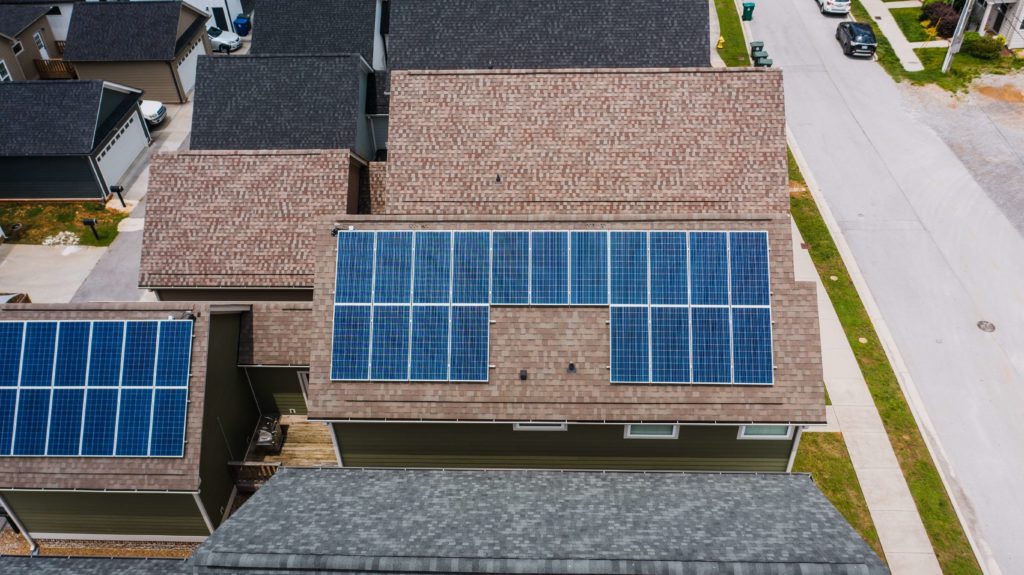Whether you own a retail business, restaurant, school or warehouse, your building likely experiences high foot traffic throughout the day and requires massive amounts of electricity. Rather than face a hefty electric bill every quarter, many business owners opt to install commercial solar panels and use their space to their advantage.
In Brisbane, business solar has taken off. In 2020, the Queensland Government reported that more than 600,000 homes and small businesses now have rooftop solar, with Mackay in one of the top five Australian solar postcodes.
Commercial solar panels allow businesses to generate their own electricity, which can be used to power everything from lights to an EFTPOS machine. Not only is this a more sustainable way to stay operational, but it can also significantly reduce your business’s electricity bill.
In this blog, we’ll explain the main differences between residential and commercial solar panels and share the three benefits of installing solar in your business.
How do commercial solar panels differ from residential solar panels?
This is one of the most commonly asked questions about commercial solar panels. While residential and commercial solar panels may look and perform similarly, there are key differences between the two products. In our experience, commercial solar needs differ from homeowners regarding generation requirements and ROI. Let’s take a look at the three differences between residential and commercial solar power systems.
- Size — As commercial buildings are drastically bigger than residential homes, the amount of solar panels needed to generate electricity is higher. The kWh amount to power appliances also increases, so your building requires a system that can handle this generation level.
- No feed-in tariff option — Unlike residential property owners, businesses cannot sell any excess renewable energy to the grid. Instead, you must shut off the inverter at the end of the day to prevent excess solar generation.
- Longer installation period — Because there’s more space to work with, your commercial solar power installation may take longer. That said, as building roofs tend to be flatter, the actual installation is simpler than a residential roof, which is typically slanted.
The three benefits of solar power for business
With the average solar investment sitting at around $40,000, it’s common for business owners to feel hesitant in making the switch. After all, your bottom line is your biggest priority. To ensure you feel confident in your decision, we’ve listed the three benefits of adding solar power to your business plan:
1. Reduce your energy bills and other operating expenses
As a business owner, finding ways to reduce operating expenses almost becomes second nature. And if your energy bills are one of your biggest expenses, switching to solar power can significantly affect your annual bill.
We crunched the numbers and found that businesses with an annual electricity bill of $60,000 who then chose to invest in solar power could potentially cut their power bills by 39% and save $23,202 every year! Having that extra cash in your pocket unlocks countless business opportunities, from expansion to purchasing new equipment.
As Queensland is known for its scorching summers, the potential generation for commercial solar power in Brisbane can guarantee a fantastic ROI. We estimate that the businesses could receive a 57% ROI in just five years, with the total payback period for your commercial solar power system sitting at just 1.7 years.
Using a commercial solar power system also reduces your business’s reliance on the grid and your electricity provider, giving you and your business greater independence.
2. Minimal maintenance required
Like residential systems, commercial solar panels are low maintenance and require little upkeep. Over time, your panels may start to have a build-up of dust and other debris. Green Energy Technologies offer ongoing maintenance for your system as part of our service. So whether you live in Townsville or the Whitsundays, simply contact us if you believe your system could use a clean, and we’ll be there in no time.
High-quality systems also tend to have a long lifespan if properly maintained, spanning anywhere from 20-25 years, giving your business access to a clean, renewable resource for several years to come.
Depending on how invested you plan to be in your system’s generation date, business owners don’t have to constantly check in on their electricity supply and can review their data feed whenever they like.
3. Build a strong brand reputation
As the country continues to make better choices around sustainability, many Australians may also look to only shop at brands or businesses that align with their values. Research from Sustainability Victoria revealed that 73% of Victorians preferred to purchase from businesses that show they care about climate change.
Business solar powersystems generate a significant amount of renewable energy, and if your business is playing a part in making the country more sustainable, it could be great marketing material for future brand awareness advertising.
Choose Green Energy Technologies for your commercial solar power installation
Whether you’re looking to take the plunge and invest in your own business solar power energy system or want to explore lease options, Green Energy Technologies can help.
We cater to the solar needs of all business customers and offer three solar options. With our Invest package, businesses can purchase a commercial solar system tailored to their requirements. The $0 Cost package allows businesses to lease a solar generator at a fixed monthly fee, while our Buy Cheaper Power option helps businesses purchase cheaper electricity from a solar generator.
No matter what option you choose, you’ll have your choice of the top quality products and ongoing service and maintenance from our CEC Accredited installers and A Grade electricians. Find out how much your commercial solar power system could cost with Green Energy Technologies by requesting a quote or giving us a call at 07 4940 2900 today.




Recent Comments